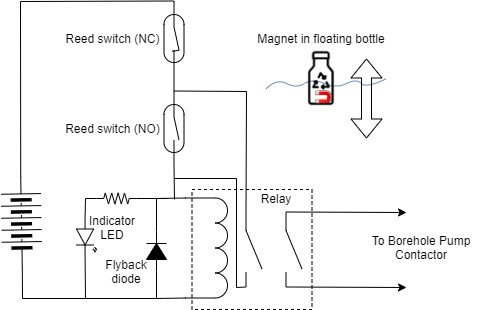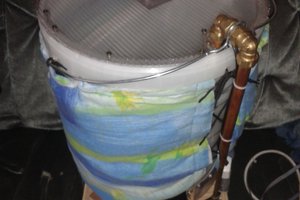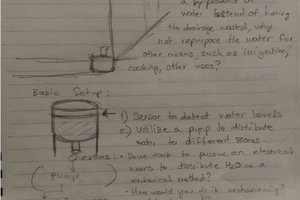Some years ago - never mind how long precisely - having little or no money in my purse, I had the water in our borehole tested, and found that it was good and eminently suitable for human consumption. Soon a reserve tank was mounted on a platform, with a booster pump beneath it, and some plumbing was perpetrated to facilitate switching between municipal and own water.
Four times a day an irrigation controller activates the borehole pump, and, while the garden is watered, the tank is also topped up via a float ball valve mounted at its inlet.
But, of course the tank is too small for when the unwashed masses want to, well, become the washed masses, which tends to happen all at once. A bigger tank might have helped, but due to the constrained purse mentioned above, as well as the limited space behind the trunk of the carob tree, a plan was devised to automatically switch on the borehole pump when water levels are low, and then of course off again when it has been filled up sufficiently.
With an aversion to drilling holes in the tank, and also not wanting to run wires into the water, as would be needed when using commercial water level switches (which I did not have anyway), I devised a setup using a magnet floating in a food-safe polyethylene bottle inside the tank (which is also made of polyethylene). The magnet is sensed using reed switches mounted on the outside of the tank, so that water and electricity do not have to mix. Two nonmagnetic stainless steel rods inside the tank form a track constraining the movement of the floating bottle to a vertical trajectory near the side of the tank.

Diagram showing self-latching relay with two reed switches activated by magnet inside the tank
Near the bottom of the tank is mounted a normally-open reed switch, which closes when dropping water levels cause the magnet to approach it. When this happens a relay is energised, which self-latches using one of its sets of contacts. The second set of contacts is connected to the contactor controlling the borehole pump, which is therefore also switched on. Eventually water wends its weary way from the depths of the earth and into the tank, causing the water level to rise. Ultimately the magnet floats up, up and away from the bottom reed switch, causing it to open again. This does not matter, though, because of the self-latched relay, which stays on, keeping the borehole pump working, until the coil current is interrupted by the top (normally closed) reed switch, which opens when the magnet eventually rises to its level. A flyback diode across the relay protects the reed switch against the back EMF generated by the coil when the current is interrupted.
This setup is attractive, not only due to the magnet, but also because it contains no sensitive electronics which can be damaged by lightning-induced spikes – a very real issue owing to the approximately 20m of unshielded wire running outside between the reed switches and the rest of the circuit, which resides in the garage near the irrigation controller. There is also no internet connectivity hassles, security challenges, spyware, or incessantly updating software to contend with. Unsurprisingly, it has functioned perfectly from day 1. Only very occasionally do I remember to use a few litres of municipal water, just to keep the meter ticking over. They have already come to replace the meter once, no doubt theorising that it was broken because it registers almost nothing per month.
Now for the fun part: Despite there being no need, there was still a desire to know the actual water level in the tank, in a similarly robust and hassle-free way. It is important to remember that everything one installs has to be maintained, so it behooves one to be circumspect regarding the future support burden that comes with every device built or acquired. Keep it simple, in other words. For a brief moment I considered mounting a manometer-style tube on the outside of the tank, with the water...
Read more »


 Morning.Star
Morning.Star
 ump
ump

 MECHANICUS
MECHANICUS
How do you keep the magnet in the tank aligned?